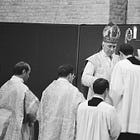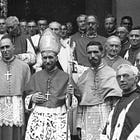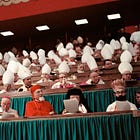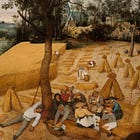What did Archbishop Lefebvre really think about the 'Conciliar Church'?
The distinction between the 'Conciliar Church' and the Roman Catholic Church is crucial to Archbishop Lefebvre's understanding of the crisis in the Church.
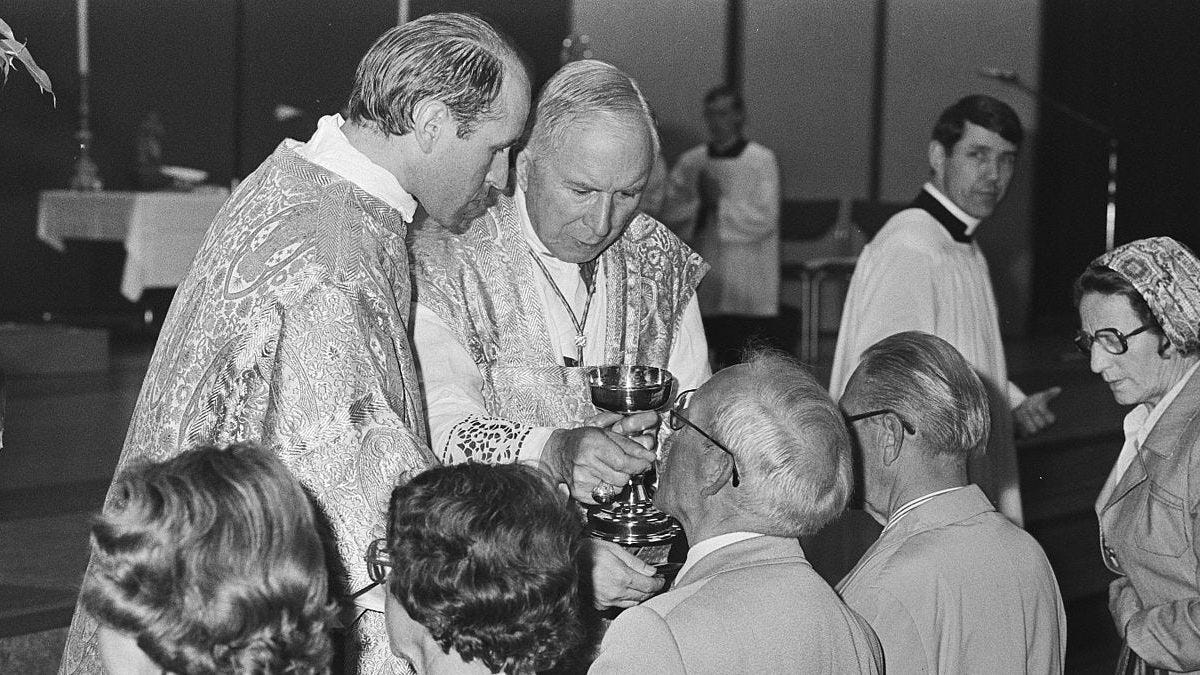
The distinction between the 'Conciliar Church' and the Roman Catholic Church is crucial to Archbishop Lefebvre's understanding of the crisis in the Church.
Editor’s Notes
This is part of an essay by John Lane, edited and expanded, with permission, by S.D. Wright.
Whatever one may think about Archbishop Lefebvre, his thoughts, words, and deeds, it is clear that he was an enormously significant figure in the twentieth century response to Vatican II.
Hence, while he is not an authority, what he thought about the Conciliar Church is an interesting and important topic in its own right.
In Decmber 2023, following the Synod on Synodality, we began using the updated term “Conciliar-Synodal Church” to refer to the latest incarnation of the conciliar church of Vatican II. In the 2024 document The Bishop of Rome, published by the Dicastery of Promoting Christian Unity, Cardinal Koch used this term, raising an amusing question: Had he and others in the Vatican been reading The WM Review?
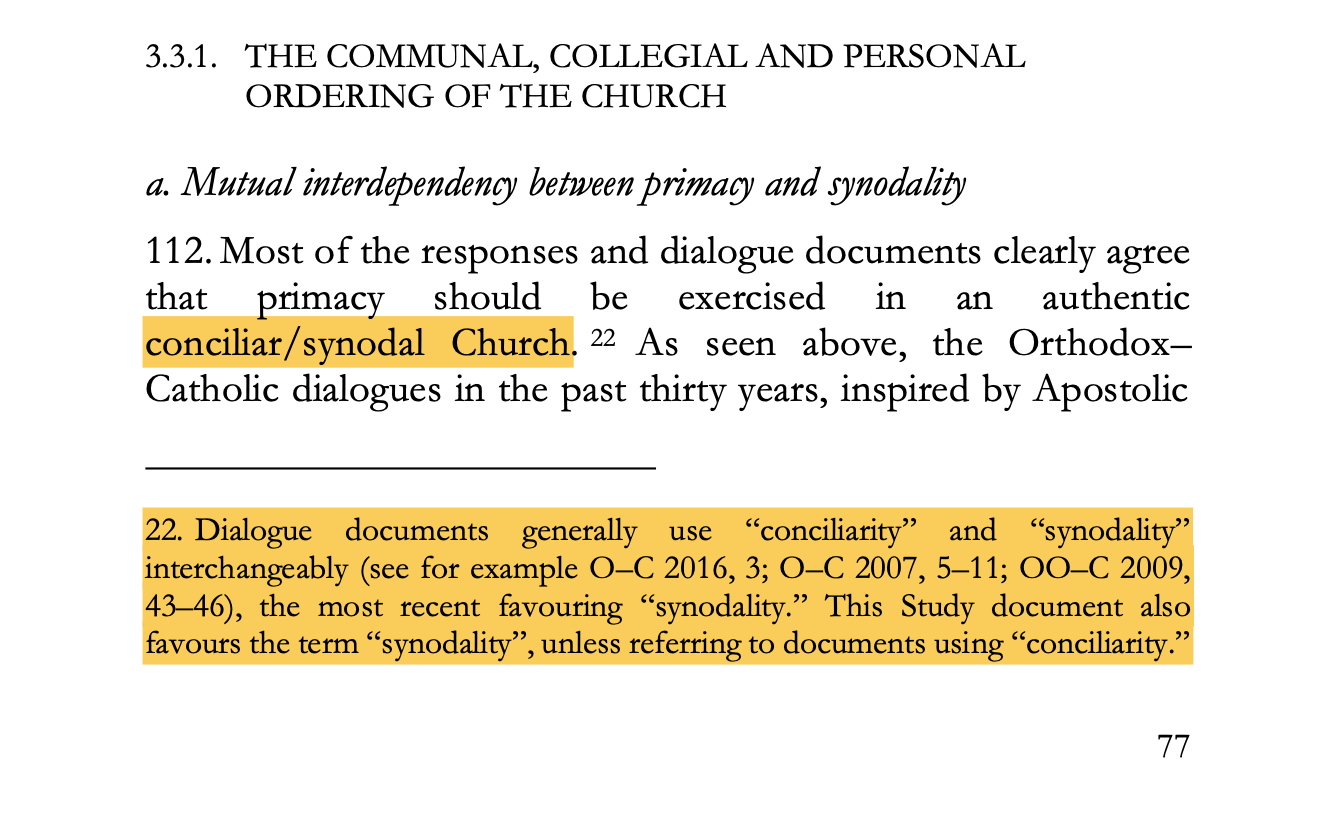
In any case, we are happy to adopt their chosen designation of Conciliar/Synodal in place of Conciliar-Synodal.
See also:
Archbishop Lefebvre and the Conciliar Church
By John Lane
Edited and expanded with permission by S.D. Wright
Overview of his thought
On countless occasions, in sermons and addresses, in documents and books, and in conversation, Archbishop Lefebvre distinguished the Conciliar Church from the Catholic Church. What did he mean by this term, “Conciliar Church”? In order to answer this question it is necessary to recall some of the many times he used it, and in what context. This exercise sheds considerable light on the Archbishop’s thought, since the notion that there is another entity, quite distinct from the Catholic Church, to which it is possible for men to belong, is central to his position on the crisis. And equally crucial to his general thesis is the notion that attachment to the Conciliar Church entails separation from the true Church.
The first and most significant of the occasions on which Archbishop Lefebvre denounced “the Conciliar Church” was in his famous declaration of 1974, which declaration supplied the necessary casus belli for Paul VI to suppress the Society of St. Pius X in 1976.
Archbishop Lefebvre declared:
“We hold firmly with all our heart and with all our mind to Catholic Rome, Guardian of the Catholic Faith and of the traditions necessary to the maintenance of this faith, to the eternal Rome, mistress of wisdom and truth.
“We refuse on the other hand, and have always refused, to follow the Rome of Neo-Modernist and Neo-Protestant tendencies which became clearly manifest during the Second Vatican Council, and after the Council, in all the reforms which issued from it.”1
After being notified of the ipso facto suspension he was supposed to have incurred by proceeding with priestly ordinations against the command of Paul VI, Archbishop Lefebvre wrote:
“It thus appears impossible to approach the basic problem, which the agreement of the Conciliar Church, as H. E. Mgr. Benelli himself calls it in his last letter, and the Catholic Church. Let there be no mistake. It is not a question of a difference between Mgr. Lefebvre and Pope Paul VI. It is a question of the radical incompatibility between the Catholic Church and the Conciliar Church, the Mass of Paul VI being the symbol and the program of the Conciliar Church.”2
In an interview in August, 1976, the Archbishop further clarified his meaning.
“[T]his Council represents, both in the opinion of the Roman authorities as in our own, a new church which they call themselves the ‘Conciliar Church’.
“We believe that we can affirm, taking into consideration the internal and external critique on Vatican II, that is, in analysing the texts and in studying its circumstances and its consequences, that the Council, turning its back on Tradition and breaking with the Church of the past, is a schismatic council. The tree is known by its fruits. Since the Council, all the larger newspapers throughout the world, American and European, recognise that it is destroying the Catholic Church to such a degree that even the unbelievers and the secular governments are worried. […]
“Accepting this new principle [of indifferentism], all the doctrine of the Church must change, as well as its cult, its priesthood, its institutions, because everything in the Church until the Council had demonstrated that she alone possessed the Way, the Truth and the Life in Our Lord Jesus Christ, Whom she kept in person in the Holy Eucharist, and Who is present thanks to the continuation of His sacrifice. Thus a total overturning of Tradition and of the teaching of the Church has occurred since the Council and through the Council.
“All those who cooperate in the application of this overturning accept and adhere to this new ‘Conciliar Church‘, (as His Excellency Mgr. Benelli called it, in the letter that he sent me in the name of the Holy Father last June 25), [they adhere to this new ‘Conciliar Church’] and they enter into the schism.”3
And in another interview given at the same time, the founder of the Society of St. Pius X emphasised the same point.
“What is schism? It is a break, a break with the Church. But a break with the Church can also be a break with the Church of the past. If someone breaks with the Church of two thousand years, he is in schism. There has already been a council which was declared schismatic. Well, it is possible that one day, in twenty years, in thirty, in fifty years – I don’t know – the Second Vatican Council could be declared schismatic, because it professed things which are opposed to the Tradition of the Church, and which have caused a break with the Church.”4
Also, at this time – in a text which is very hard to find in English today:
“We are suspended a divinis by the Conciliar Church and for the Conciliar Church, to which we have no wish to belong. That Conciliar Church is a schismatic Church, because it breaks with the Catholic Church that has always been. It has its new dogmas, its new priesthood, its new institutions, its new worship, all already condemned by the Church in many a document, official and definitive….
“The Church that affirms such errors is at once schismatic and heretical. This Conciliar Church is, therefore, not Catholic. To whatever extent Pope, Bishops, priests, or faithful adhere to this new Church, they separate themselves from the Catholic Church.”5
We see in this text a reserve, even when very forceful. It must not be supposed that by the simple distinction between the Conciliar Church and the Catholic Church the Archbishop was asserting that the entire hierarchy had defected. This he did not believe. This text shows his avoidance of such a gratuitous and simplistic generalisation.
Summarising his position, a few weeks later, he wrote:
“In so far as the new Church separates itself from the old Church we cannot follow it. That is the position, and that is why we maintain Tradition, we keep firmly to Tradition; and I am sure we are being of immense service to the Church.”6
In his 12th Letter to Friends and Benefactors, in March 1977, Archbishop Lefebvre said:
“This new attitude of the Church authorities is a negation of the Cross of Our Lord. To ask us to follow this attitude, which lay under the surface during the Council, and which is clearly expressed in the reforms and practice of the Conciliar Church, is as much as to ask us to deny Christ crucified. We cannot do so.”7
Now some have been tempted to think that the Archbishop only made these comments under the influence of passion, and that he exaggerated. It may well be true that passion caused him to use language that his diplomatic training and experience would usually have guided him to avoid. But the content of this analysis would remain his true thought until his dying day, fourteen years later.
Whatever the language employed, the underlying analysis did not alter. In his sermon for the ordinations of 29 June 1978, he explained:
“I believe that I have the right to ask these gentlemen who present themselves in offices which were occupied by Cardinals (who were indeed saintly persons and who were defenders of the Church and of the Catholic Faith) it seems to me that I would have the right to ask them, “Are you with the Catholic Church?” “Are you the Catholic Church?” “With whom am I dealing?” If I am dealing with someone who has a pact with Masonry, have I the right to speak with such a person? Have I the duty to listen to them and to obey them?”8
Also in 1978, after describing the fruitfulness of the traditional apostolate, the founder of Econe drew the theological conclusion:
“How can one avoid the conclusion: there where the faith of the Church is, there also is her sanctity, and there where the sanctity of the Church is, there is the Catholic Church. A Church which no longer brings forth good fruits, a Church which is sterile, is not the Catholic Church.”9
In 1983, his thought was identical:
“Exactly the same day nine years ago on the 21st of November, I drew up a manifesto which also brought down on me the persecution of Rome, in which I said I can’t accept Modernist Rome. I accept the Rome of all time with its doctrine and with its Faith. That is the Rome we are following, but the Modernist Rome which is changing religion? I refuse it and I reject it. And that is the Rome which was introduced into the Council and which is in the process of destroying the Church. I refuse that Church.”10
Not only did he refuse this “Church”, but towards the end of his life he wrote in the book Spiritual Journey:
“It is, therefore, a strict duty for every priest wanting to remain Catholic to separate himself from this Conciliar Church for as long as it does not rediscover the Tradition of the Church and of the Catholic Faith.”11
Echoed by the Society after the consecrations
This statement was echoed in his lifetime by his own sons, in an open letter from the District Superiors to Cardinal Gantin, following the consecrations and subsequent excommunications:
Open Letter to Cardinal Gantin Prefect of the Congregation for Bishops
From the District Superiors of the SSPX, July 6 1988You thought it good, by your letter of July 1st, to inform Their Excellencies Archbishop Marcel Lefebvre, Bishop Antonio de Castro Mayer, and the four Bishops whom they consecrated on June 30, at Ecône, of the excommunication latæ sententiæ. We let you judge for yourself the value of such a declaration, coming from an authority who, in its exercise, breaks with all its predecessors down to Pope Pius XII, in worship, teaching and government of the Church.
As for us, we are in full communion with all the Popes and Bishops before the Second Vatican Council, celebrating precisely the Mass which they codified and celebrated, teaching the Catechism which they drew up, standing up against the errors which they have many times condemned in their encyclicals and pastoral letters. We let you judge on which side the rupture is to be found. We are extremely saddened by the blindness of spirit and the hardening of heart of the Roman authorities.
On the other hand, we have never wished to belong to this system which calls itself the Conciliar Church, and defines itself with the Novus Ordo Missæ, an ecumenism which leads to indifferentism and the laicization of all society. Yes, we have no part, nullam partem habemus, with the pantheon of the religions of Assisi; our own excommunication by a decree of Your Eminence or of another Roman Congregation would only be the irrefutable proof of this. We ask for nothing better than to be declared out of communion with this adulterous spirit which has been blowing in the Church for the last 25 years; we ask for nothing better than to be declared outside of this impious communion of the ungodly. We believe in the One God, Our Lord Jesus Christ, with the Father and the Holy Ghost, and we will always remain faithful to His unique Spouse, the One Holy Catholic Apostolic and Roman Church.
To be publicly associated with this sanction which is inflicted upon the six Catholic Bishops, Defenders of the Faith in its integrity and wholeness, would be for us a mark of honor and a sign of orthodoxy before the faithful. They have indeed a strict right to know that the priests who serve them are not in communion with a counterfeit church, promoting evolution, pentecostalism and syncretism.12 (Emphases added)
Archbishop Lefebvre before the CDF
Now in 1979, two comments of Archbishop Lefebvre, including one of those given above, were made the basis of an examination, in person, by the Congregation of the Doctrine of the Faith. Here are the minutes:
Minutes of the Examination of Archbishop Lefebvre by the CDF, January 1979
CDF: In a preliminary note (12 July 1976) to a letter addressed to the Holy Father, you [Archbishop Lefebvre] wrote:
“Let there be no mistake, it is not a question of a dispute between Mgr. Lefebvre and Pope Paul VI. It is a question of the radical incompatibility of the Catholic Church and the Conciliar Church, the Mass of Paul VI representing the program of the Conciliar Church.”
That idea is made explicit in the homily given on the preceding 29 June during the ordination Mass at Ecône:
“Well! It is precisely the insistent demands of those sent from Rome that we change our rite which makes us reflect. And we are convinced that this new rite of Mass expresses a new faith, a faith which is not ours, a faith which is not the Catholic Faith. This new Mass is a symbol, an expression, an image of a new faith, a Modernist faith…It is plain that this new rite is subtended, so to say, it supposes another conception of the Catholic faith, another religion… Slowly but surely the Protestant notion of the Mass is being introduced into Holy Church.”
Question: Are we to conclude from those statements that according to you, the Pope, promulgating and imposing the new Ordo Missae, and all the bishops who have received it, have founded and assembled visibly around them a new “Conciliar” Church radically incompatible with the Catholic Church?
Answer: (Archbishop Lefebvre): I remark, first of all, that the expression “Conciliar Church” comes not from me but from H.E. Mgr. Benelli who, in an official letter, asked that our priests and seminarians should submit themselves to the “Conciliar Church.”
I consider that a spirit tending to Modernism and Protestantism shows itself in the conception of the new Mass and in all the Liturgical Reform as well. Protestants themselves say that it is so, and Mgr. Bugnini himself admits it implicitly when he states that this Liturgical Reform was conceived in an ecumenical spirit. (I could prepare a study showing how that Protestant spirit exists in the Ordo Missae.)13
He did not quail before the examiners; there was no withdrawal of the term “Conciliar Church” or undermining of its meaning—although he assigned its origin to another. In fact, Lefebvre was incorrect about the origin of the term “Conciliar Church”: it was first used by Paul VI himself in an address to lay leaders in 1966, when he said:
“For it is not a matter merely of collecting and spreading the council’s teachings, but of transforming oneself into the image of the conciliar Church.”14
Instead of withdrawing or undermining his use of the term, Archbishop Lefebvre explained what it signified—viz. that the new liturgy expresses a new religion, Modernist and Protestant. Later in the same interview, he was asked directly:
QUESTION: Do you hold that a faithful Catholic can think and say that a sacramental rite, in particular that of the Mass, approved and promulgated by the Sovereign Pontiff, can be out of conformity with the Catholic faith or “favoring heresy”?
ANSWER: That rite in itself does not profess the Catholic faith in as clear a manner as did the old Ordo Missae, and consequently it can favor heresy. But I do not know to whom to attribute it, nor if the Pope is responsible for it.
What is astounding is that an Ordo Missae savoring of Protestantism and therefore “favoring heresy” should be spread abroad by the Roman Curia.15
It is instructive that the Archbishop does not deny the premises of the question – namely that a papally-promulgated rite cannot “be out of conformity with the Catholic faith or “favoring heresy”. He does not present a convoluted explanation, claiming that it had not been “infallibly imposed” (whatever that means), as some do today. He refuses to concede that this rite has come from the Church, which is preserved from such things. Instead, he questions whether it had truly received papal approval and promulgation. This is instructive for us today: it is now impossible to wonder whether it has the approval of Paul VI and his successors, but the principles he appears keen to accept are as sound and as certain as ever. A certain conclusion follows, but that is not for this essay.
In the same examination by the CDF, he was asked to explain his actions in conferring sacraments in dioceses without the approval of the ordinaries of those dioceses. His answers were illuminating.
Question: Is not that to think and act as though the legitimate hierarchy did not exist, and to begin to form, willingly or not, a dissident community?
Answer (Archbishop Lefebvre): It may be thought that in a general way, in some countries, the hierarchy is not playing its part. There is no question of my founding a dissident community, but of ensuring that the Catholic Church continues on a basis of Canon Law and the great principles of theology.”16
It is sufficiently clear from this answer that the Archbishop regarded the situation as an emergency in which the faithful had been left without true pastors. In the history of the Church, there exist examples of neighbouring bishops coming to the aid of those abandoned by heretical pastors. This principle is made more explicit in the Archbishop’s reply to a later question:
Continued minutes of the Examination, January 1979
Question: In your letter of 13 April 1978 to the Sacred Congregation you enclosed “General considerations on the state of the Church since Vatican Council II which alone permit of an adequate reply to the questions asked about the Ordo Missae, our continuation of the activity of the Priestly Fraternity of St. Pius X in spite of the interdictions received from the bishops and from Rome.”
On the basis of those considerations, it seems to us that your position can be stated in the following thesis:
A bishop, judging in conscience that the Pope and the Episcopate are in general no longer using their authority to ensure the faithful an exact transmission of the faith, may legitimately, so as to maintain the Catholic faith, ordain priests without being a diocesan bishop, without having received dimissorial letters and against the formal and express prohibition of the Pope, and may assign to those priests the exercise of the ecclesiastical ministry in different dioceses.
Does that thesis state your position correctly?
Is that thesis in conformity with the traditional doctrine of the Church to which you mean to hold fast?
Answer (Archbishop Lefebvre): You are setting a trap for me!
To a) No. I have not acted, starting from a principle like that one. It is the facts, the circumstances in which I found myself, which compelled me to take certain positions, and in particular the fact that I had in the Fraternity of St. Pius X a work already legally constituted which I had to continue.
To b) I think that history can furnish examples of similar acts done, in certain circumstances, not against but aside from the will of the Pope. But this question is too serious and too important to be answered at once. I prefer, therefore, to postpone my answer.
Here is the written answer he gave soon after:
Written Answer Given by Mgr. Lefebvre the Next Day, 13 January 1979
In the case where the Roman Curia sends out documents or performs acts inspired by a Liberal and Modernist spirit, it is the duty of the bishops to protest publicly and to object.
Similarly, if the Catholic Universities and the Seminaries are themselves infested with Liberalism and Modernism, it is the duty of the bishops to found Seminaries in which Catholic doctrine is taught.
If whole countries fall into Modernism, Liberalism and Marxism, and the faithful, aware of the danger to their faith, ask for faithful priests to serve them and their children, it is the duty of the bishops who have stayed Catholic to respond to their appeal.
St. Athanasius, St. Eusebius of Samosata, and St. Epiphanius asserted and acted on those same principles, which stand to reason when the state of the Church is catastrophic. It is also obvious that those bishops should make every effort to help the Pope provide remedies for that situation.17
‘State of emergency’
It is noteworthy that the thesis of the state of emergency was then presented with such clarity so many years before the episcopal consecrations which brought it to such prominence. It is also of great significance that the Archbishop was already, in 1978, putting forth the example of St. Eusebius of Samosata as justification for his acts. This historical case, which was studied in such detail by the venerated Dom Gréa in his work on the hierarchy of the Church, certainly justifies not only the conferral of sacraments in other dioceses, but even the consecration of bishops without papal mandate.
The fundamental principles which Dom Gréa identified, and upon which Archbishop Lefebvre explicitly acted, were the abandonment of the faithful by their lawful pastors, and the inability to refer to the Roman Pontiff. In such circumstances, explains Dom Gréa, true Successors of the Apostles are entitled to treat these abandoned dioceses as missionary territory, and act to restore the Church just as if they were establishing it from the beginning.
For Archbishop Lefebvre, the Church was in a state of emergency brought about by the refusal of the bishops to profess the faith and to succour the faithful with true doctrine, certainly valid sacraments, and the mass of all time. The Modernist bishops had implicitly resigned as pastors of their faithful. By the mid-1980s, he had also formed the view that the Roman Pontiff was at least morally inaccessible.
The connection of these notions to the thesis that there were two entities, one the Catholic Church which he was continuing, and another new Church which was destroying the true Church, is obvious. Those bishops who formally adhered to the programme of Vatican II and its reforms, had abandoned the Church.
In case this interpretation seems in any way forced, let the reader consider the letter that Archbishop wrote to Bishop de Castro Mayer towards the end of both of their lives, in 1990, urging him to agree to the consecration of a successor. In this important letter, he made the distinction between the true Church and the new church the foundation of the radical act he was recommending:
“[T]he Conciliar Church, having now reached everywhere, is spreading errors contrary to the Catholic Faith and, as a result of these errors, it has corrupted the sources of grace, which are the Holy Sacrifice of the Mass and the Sacraments. This false Church is in an ever-deeper state of rupture with the Catholic Church. Resulting from these principles and facts is the absolute need to continue the Catholic episcopacy in order to continue the Catholic Church. […]
“This is how the succession of bishops came about in the early centuries of the Church, in union with Rome, as we are too in union with Catholic Rome and not Modernist Rome.”18
In light of these considerations, a strange and terrifying situation appears. What did the Archbishop have in mind, when he used the term “Conciliar Church”?
Was it a real entity, consisting of actual members who themselves were its component parts, or merely a kind of metaphor which would assist in explaining the crisis?
These issues and more will be discussed in due course.
HELP KEEP THE WM REVIEW ONLINE!
As we expand The WM Review we would like to keep providing free articles for everyone.
Our work takes a lot of time and effort to produce. If you have benefitted from it please do consider supporting us financially.
A subscription from you helps ensure that we can keep writing and sharing free material for all. Plus, you will get access to our exclusive members-only material.
(We make our members-only material freely available to clergy, priests and seminarians upon request. Please subscribe and reply to the email if this applies to you.)
Subscribe now to make sure you always receive our material. Thank you!
Further reading:
Follow on Twitter, YouTube and Telegram:
Archbishop Lefebvre, Declaration, November 21, 1974. Emphasis added. https://web.archive.org/web/20211222171022/https://sspx.org/en/1974-declaration-of-archbishop-lefebvre
Note of July 12, 1976, to the Agence France-Presse. https://web.archive.org/web/20211213201555/http://www.sspxasia.com/Documents/Archbishop-Lefebvre/Apologia/Vol_one/Chapter_12.htm
Interview with Archbishop Lefebvre in Écône, on August 2, 1976 and published in the French magazine Le Figaro, August 4, 1976. Emphasis added. https://web.archive.org/web/20211129063543/http://fsspx.com/Communicantes/Oct2002/Servile_Obedience.htm
Interview Given to the Nouvelliste of Sion, Valais, Switzerland, at Econe on August 3, 1976 and Printed on August 4, 1976. Emphasis added. https://web.archive.org/web/20211213201555/http://www.sspxasia.com/Documents/Archbishop-Lefebvre/Apologia/Vol_one/Chapter_12.htm
Archbishop Lefebvre, Reflections on Suspension a divinis, June 29, 1976. Emphasis added. This text is now difficult to find in English from an SSPX source – nonetheless, here it is in French: https://web.archive.org/web/20211218101234/http://laportelatine.org/formation/crise-eglise/rapports-rome-fsspx/reflexions-de-mgr-lefebvre-a-propos-de-la-suspens-a-divinis-le-29-juillet-1976 and https://laportelatine.org/formation/crise-eglise/rapports-rome-fsspx/reflexions-de-mgr-lefebvre-a-propos-de-la-suspens-a-divinis-le-29-juillet-1976
Archbishop Lefebvre, Press conference given at Econe on September 15, 1976. https://web.archive.org/web/20211213201524/http://www.sspxasia.com/Documents/Archbishop-Lefebvre/Apologia/Vol_one/Chapter_14.htm
Letter to Friends and Benefactors, 19 March 1977. Emphasis added. https://web.archive.org/web/20211222170506/https://fsspx.org/en/publications/letters/march-1977-superior-generals-letter-12-743
Ordination Sermon, June 29, 1978. Emphasis added. https://web.archive.org/web/20150816130135/http://www.sspxasia.com/Documents/Archbishop-Lefebvre/Apologia/Vol_two/Chapter_23.htm
Letter to Friends and Benefactors, no. 15, 8 September 1978. https://web.archive.org/web/20211222170245/https://www.sspxasia.com/Documents/Archbishop-Lefebvre/Letter_to_Friends_and_Benfactors_15.htm
Press Conference, Paris, 9 December 1983. https://web.archive.org/web/20211220230747/http://www.sspxasia.com/Documents/Archbishop-Lefebvre/Press-Conference.htm
Archbishop Lefebvre, Spiritual Journey, Angelus Press, Kansas City Missouri, 1991. Available at: https://web.archive.org/web/20211222164724/http://www.fsspx.com/Communicantes/July2002/Spiritual_Journey.htm
District Superiors of the SSPX, Open Letter to Cardinal Gantin Prefect of the Congregation for Bishops, July 6 1988. Available at: https://web.archive.org/web/20211222165521/https://www.sspxasia.com/Documents/Archbishop-Lefebvre/Archbishop_Lefebvre_and_the_Vatican/Part_I/1988-07-06.htm
Examination before the Congregation of the Doctrine of the Faith, January 11 and 12, 1979. https://web.archive.org/web/20210801190211/https://www.sspxasia.com/Documents/Archbishop-Lefebvre/Apologia/Vol_two/Chapter_32.htm
Paul VI, Address to Members of the Permanent Committee of the International Congresses for the Apostolate of the Laity, Mar. 8, 1966; underlining added. Translation taken from The Messenger, Mar. 18, 1966, p. 3.)
With thanks to Novus Ordo Watch for drawing this to our attention.
Ibid.
Ibid.
Ibid.
Archbishop Lefebvre, Letter to Bishop de Castro Mayer December 4, 1990. https://web.archive.org/web/20211222170015/http://www.sspxasia.com/Documents/Archbishop-Lefebvre/Letter_to_Bishop_de_Castro_Mayer.htm



